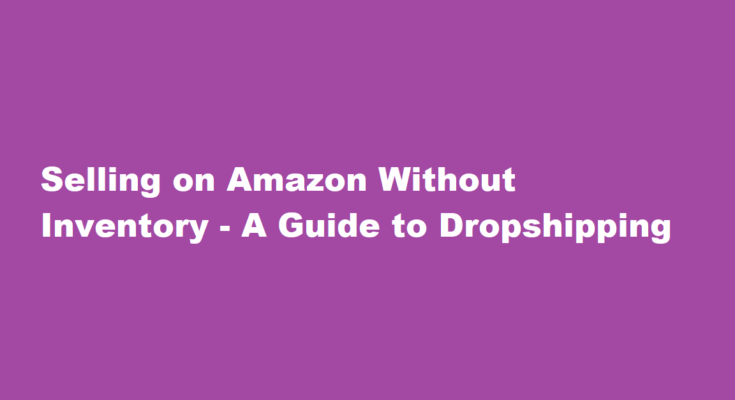Introduction
Amazon has emerged as one of the largest and most lucrative online marketplaces, providing entrepreneurs with numerous opportunities to build a successful e-commerce business. One popular method for selling on Amazon without holding inventory is dropshipping. Dropshipping allows sellers to list products for sale on Amazon and only purchase items from suppliers when customers place orders. This method eliminates the need for costly inventory management and can be an excellent way to start or expand your e-commerce business. In this article, we’ll delve into the world of dropshipping on Amazon and discuss the steps to get started.
Understanding Dropshipping
Dropshipping is a retail fulfillment method where sellers do not keep the products they sell in stock. Instead, they partner with suppliers who hold the inventory and fulfill orders as they come in. This means that as an Amazon seller using dropshipping, you won’t need to worry about warehousing, packing, or shipping the products yourself. Your primary role is to list products on Amazon, attract customers, and process orders. Here are the key steps to start dropshipping on Amazon without holding inventory:
Select Your Niche
To begin your dropshipping journey on Amazon, it’s essential to choose a niche or category of products you want to sell. Consider your interests, market demand, and competition when selecting your niche. Research potential niches using Amazon’s Best Sellers, Google Trends, and tools like Jungle Scout to identify profitable product categories.
Legal and Tax Considerations
Before you start selling on Amazon, ensure that you have all the necessary legal and tax documentation in place. This includes registering your business, obtaining an Employer Identification Number (EIN), and understanding the tax obligations in your region. Consult with a legal or financial advisor if needed to ensure compliance.
Create an Amazon Seller Account
Sign up for an Amazon seller account. There are two types of seller accounts: Individual and Professional. The Professional account is recommended for dropshippers as it provides access to advanced selling tools and features. Pay the associated fees and complete the registration process.
Find Reliable Suppliers
Choosing reputable suppliers is critical for the success of your dropshipping business. Look for suppliers with a good track record of reliability and quality products. Some popular sources for finding suppliers include AliExpress, SaleHoo, and Oberlo. Evaluate their shipping times, product quality, and customer service.
Product Listing and Optimization
List the products you want to sell on Amazon’s platform. Ensure that your product listings are well-optimized with high-quality images, compelling product descriptions, and competitive pricing. Use relevant keywords and consider Amazon SEO best practices to enhance your product’s visibility.
Pricing Strategy
Set your prices to ensure profitability. Be mindful of the cost of goods from your supplier, Amazon referral fees, and any additional expenses such as advertising. Price your products competitively while maintaining a reasonable profit margin.
Order Processing
As a dropshipper, you only purchase products from your supplier when a customer places an order on Amazon. When an order is received, communicate the order details to your supplier, including the customer’s shipping address. Many dropshipping tools and software can automate this process, making it more efficient.
Customer Service
Provide excellent customer service to build trust and ensure customer satisfaction. Be responsive to customer inquiries and address any issues promptly. Maintain a good reputation by resolving problems, managing returns, and handling refunds in a timely manner.
Marketing and Promotion
To drive traffic to your Amazon listings, invest in marketing and promotional efforts. Use Amazon PPC (Pay-Per-Click) advertising, social media marketing, and email marketing to increase visibility and attract potential customers. Monitor the performance of your marketing campaigns and adjust your strategies accordingly.
Analytics and Optimization
Analyze your sales and performance regularly to identify trends, popular products, and areas for improvement. Amazon offers various analytics tools to help you make informed decisions about your product selection, pricing, and marketing strategies.
Scaling Your Business
Once you have established a successful dropshipping business on Amazon, consider expanding your product range, exploring new niches, or diversifying your sales channels. You can also consider using fulfillment services like Amazon FBA (Fulfillment by Amazon) to further streamline your operations and enhance customer service.
FREQUENTLY ASKED QUESTIONS
Can I sell on Amazon without having products?
The most obvious option for selling on Amazon without storing your own inventory is using the fulfillment by Amazon (FBA) service. FBA lets you outsource the work of storing and shipping products to Amazon fulfillment centers. Of course, using FBA does mean paying Amazon more in fees.
Can we sell on Amazon without FBA?
Amazon FBA’s restrictions often prove to be inadequate for fast growing brands selling across multiple sales channels. Working with a 4PL, such as Ware2Go, allows these merchants to sell on Amazon without FBA and deliver affordable 1-2-day shipping.
Conclusion
Selling on Amazon without inventory through dropshipping can be a lucrative business model for entrepreneurs looking to enter the world of e-commerce. By following the steps outlined in this article, you can start your dropshipping journey and build a successful business on Amazon. Remember to choose your niche wisely, partner with reliable suppliers, optimize your listings, provide exceptional customer service, and continually refine your strategies to maximize your success in the competitive e-commerce marketplace. With dedication and effort, you can create a profitable and sustainable e-commerce business without the need to maintain inventory.
Read Also : A Step-by-Step Guide – How to Remove a Toilet



